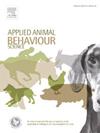被车灯捕捉:在即将发生碰撞的场景中,圈养的白尾鹿对车辆照明变化的反应
IF 2.2
2区 农林科学
Q1 AGRICULTURE, DAIRY & ANIMAL SCIENCE
引用次数: 0
摘要
在美国,车辆与鹿(Odocoileus spp.)的碰撞每年造成数十亿美元的损失,并使数千名司机受伤,但很少有缓解方法被证明是有效的。然而,最近的研究表明,车辆照明可能会影响白尾鹿(Odocoileus virginianus;此后,鹿对迎面而来的车辆作出反应。大多数新车都是用发光二极管(LED)大灯制造的,与以前的工业标准钨卤大灯相比,发光二极管(LED)大灯的总辐射和发光波长有所不同。此外,通过后向照明的正面车辆照明在增强鹿对车辆的反应方面表现出了希望,但其有效性尚未在各种前照灯条件下(前照灯类型或强度)进行测试。因此,目前尚不清楚车辆照明的这些方面如何影响鹿对接近车辆的反应。我们使用了23只圈养的野生型鹿来研究车辆照明的变化如何影响鹿在夜间对接近车辆的反应,这是大多数碰撞发生的时候。我们将鹿放入一个长95 米、宽3 米的溜槽中,然后用一辆电动高尔夫球车从另一端靠近它们,车上装有两款2017-2020年福特Fusion前大灯(LED和卤素灯),以及一个51 厘米的尾灯条,以测试车辆照明在即将发生正面碰撞的情况下如何影响鹿的躲避行为。每只鹿都接受了8种光照处理,包括头灯类型(LED与卤素灯)、光强(低光与远光)和尾灯(灯条关闭与打开)的独特组合。我们用红外摄像测量了鹿的警觉和飞行行为。我们发现卤素、远光灯、灯条关闭的处理最有可能引起警觉反应。此外,当灯条关闭时,远光灯似乎增加了卤素大灯的警报概率。此外,我们发现有证据表明,当灯条关闭时,远光灯卤素大灯比远光灯LED大灯更容易提高警觉性。我们发现光照处理对鹿的警戒距离、飞行概率或飞行起始距离没有影响。在所有的行为反应中,随机效应鹿ID比我们的光照处理解释了0.86-9.19 × 更多的变化,反映了鹿之间反应的巨大差异。总体而言,我们发现车辆照明可以影响鹿在迫在眉睫的正面碰撞场景中的行为,尽管照明在增加有利的飞行行为方面是无效的。未来的研究应该调查车辆照明处理如何影响自由放养的野鹿在各种现实场景和更长的接近距离。本文章由计算机程序翻译,如有差异,请以英文原文为准。
Caught in headlights: Captive white-tailed deer responses to variations in vehicle lighting during imminent collision scenarios
Vehicle collisions with deer (Odocoileus spp.) cause billions of dollars in damages and injure thousands of drivers every year in the United States, and few mitigation methods have proven effective. However, recent research suggests that vehicle lighting might influence white-tailed deer (Odocoileus virginianus; hereafter, deer) responses to oncoming vehicles. Most new vehicles are manufactured with light emitting diode (LED) headlights which differ in total radiance and wavelength of light emitted compared to the previous industry standard of tungsten-halogen (halogen) headlights. Also, frontal vehicle illumination through rear-facing lighting has shown promise in enhancing deer responses to vehicles, but its effectiveness has not been tested under various headlight conditions (headlight type or intensity). As such, it remains unclear how these aspects of vehicle lighting affect deer responses to an approaching vehicle. We used 23 captive, wild-type deer to investigate how variations in vehicle lighting affect deer responses to an approaching vehicle at night, when most collisions occur. We released deer into a 95 m long, 3 m wide chute and approached them from the opposite end with an electric golf cart outfitted with two versions of stock 2017–2020 Ford Fusion headlights (LED and halogen) and a 51 cm rear-facing lightbar to test how vehicle lighting affected deer avoidance behaviors in an imminent, head-on collision scenario. Each deer received eight lighting treatments consisting of unique combinations of headlight type (LED vs. halogen), light intensity (low vs. high beam), and rear-facing lighting (lightbar off vs. on). We measured deer alert and flight behavior using infrared videography. We found that the halogen, high beam, lightbar off treatment had the greatest probability of evoking an alert response. Furthermore, when the lightbar was off, high beams appeared to increase alert probability for halogen headlights. Also, we found evidence that high beam, halogen headlights tend to increase alert probability over high beam, LED headlights, when the lighbar was off. We found no effect of our lighting treatments on deer alert distance, flight probability, or flight initiation distance. Across all behavioral responses, the random effect deer ID explained 0.86–9.19 × more variation than our lighting treatments, reflecting large differences in responses among deer. Overall, we found that vehicle lighting can impact deer behavior during an imminent, head-on collision scenario, although lighting was ineffective at increasing favorable flight behaviors. Future research should investigate how vehicle lighting treatments affect free-ranging, wild deer in a variety of real-world scenarios and at longer approach distances.
求助全文
通过发布文献求助,成功后即可免费获取论文全文。
去求助
来源期刊

Applied Animal Behaviour Science
农林科学-行为科学
CiteScore
4.40
自引率
21.70%
发文量
191
审稿时长
18.1 weeks
期刊介绍:
This journal publishes relevant information on the behaviour of domesticated and utilized animals.
Topics covered include:
-Behaviour of farm, zoo and laboratory animals in relation to animal management and welfare
-Behaviour of companion animals in relation to behavioural problems, for example, in relation to the training of dogs for different purposes, in relation to behavioural problems
-Studies of the behaviour of wild animals when these studies are relevant from an applied perspective, for example in relation to wildlife management, pest management or nature conservation
-Methodological studies within relevant fields
The principal subjects are farm, companion and laboratory animals, including, of course, poultry. The journal also deals with the following animal subjects:
-Those involved in any farming system, e.g. deer, rabbits and fur-bearing animals
-Those in ANY form of confinement, e.g. zoos, safari parks and other forms of display
-Feral animals, and any animal species which impinge on farming operations, e.g. as causes of loss or damage
-Species used for hunting, recreation etc. may also be considered as acceptable subjects in some instances
-Laboratory animals, if the material relates to their behavioural requirements
 求助内容:
求助内容: 应助结果提醒方式:
应助结果提醒方式:


